小学英语语法写作
- 格式:ppt
- 大小:1.02 MB
- 文档页数:12
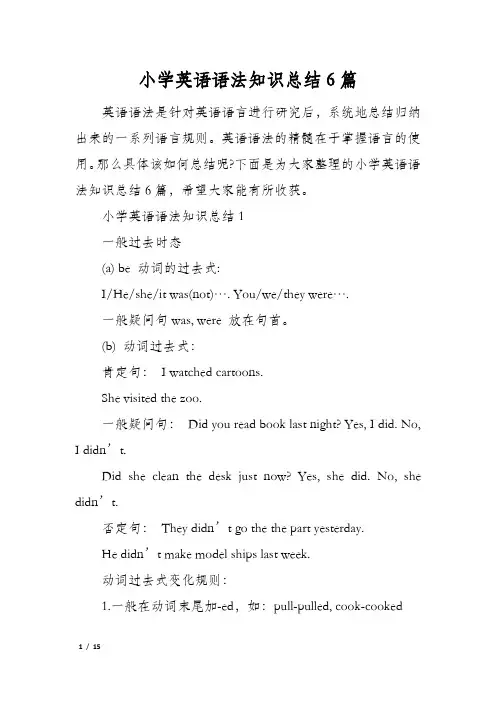
小学英语语法知识总结6篇英语语法是针对英语语言进行研究后,系统地总结归纳出来的一系列语言规则。
英语语法的精髓在于掌握语言的使用。
那么具体该如何总结呢?下面是为大家整理的小学英语语法知识总结6篇,希望大家能有所收获。
小学英语语法知识总结1一般过去时态(a) be 动词的过去式:I/He/she/it was(not)…. You/we/they were….一般疑问句was, were 放在句首。
(b) 动词过去式:肯定句:I watched cartoons.She visited the zoo.一般疑问句:Did you read book last night? Yes, I did. No, I didn’t.Did she clean the desk just now? Yes, she did. No, she didn’t.否定句:They didn’t go the the part yesterday.He didn’t make model ships last week.动词过去式变化规则:1.一般在动词末尾加-ed,如:pull-pulled, cook-cooked2.结尾是e加d,如:taste-tasted3.末尾是辅音字母加一个元音字母和一个辅音字母的重读闭音节,应双写末尾的辅音字母,再加-ed,如:stop-stopped4.以“辅音字母+y”结尾的,变y为i,再加-ed,如:study-studied5.不规则动词过去式:am,is-was,are-were,do-did,see-saw,say-said,give-gave,get-got,go-went,come-came,have-had,eat-ate,take-took,run-ran,sing-sang,put-put,make-made,read-read,write-wrote,draw-drew,drink-drank,swim-swam,sit-sat小学英语语法知识总结2动词加ing的变化规则1.一般情况下,直接加ing,如:cook-cooking2.以不发音的e结尾,去e加ing,如:make-making, taste-tasting3.如果末尾是辅音字母加一个元音字母和一个辅音字母,双写末尾的辅音字母,再加ing,如:run-running, stop-stopping 现在进行时,用来表示正在进行或发生的动作。
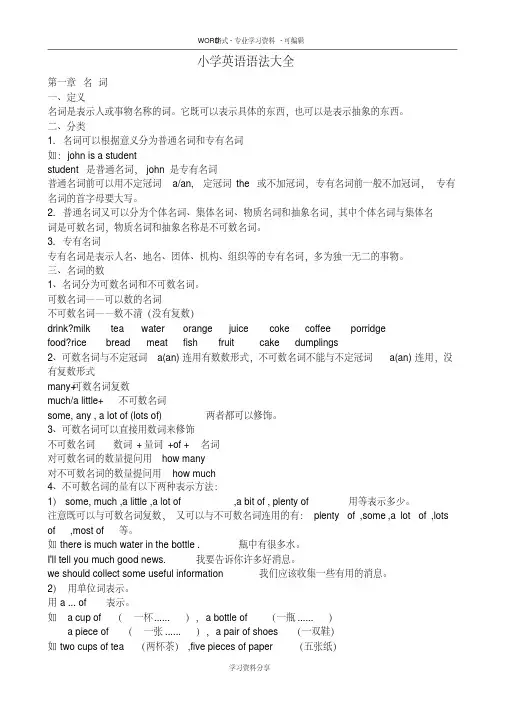
小学英语语法大全第一章名词一、定义名词是表示人或事物名称的词。
它既可以表示具体的东西,也可以是表示抽象的东西。
二、分类1. 名词可以根据意义分为普通名词和专有名词如:john is a studentstudent是普通名词,john是专有名词普通名词前可以用不定冠词a/an, 定冠词the 或不加冠词,专有名词前一般不加冠词,专有名词的首字母要大写。
2. 普通名词又可以分为个体名词、集体名词、物质名词和抽象名词,其中个体名词与集体名词是可数名词,物质名词和抽象名称是不可数名词。
3. 专有名词专有名词是表示人名、地名、团体、机构、组织等的专有名词,多为独一无二的事物。
三、名词的数1、名词分为可数名词和不可数名词。
可数名词——可以数的名词不可数名词——数不清(没有复数)drink?milk tea water orange juice coke coffee porridgefood?rice bread meat fish fruit cake dumplings2、可数名词与不定冠词a(an)连用有数数形式,不可数名词不能与不定冠词a(an)连用,没有复数形式many+可数名词复数much/a little+不可数名词some, any , a lot of (lots of) 两者都可以修饰。
3、可数名词可以直接用数词来修饰不可数名词数词 +量词 +of + 名词对可数名词的数量提问用how many对不可数名词的数量提问用 how much4、不可数名词的量有以下两种表示方法:1) some, much ,a little ,a lot of ,a bit of , plenty of 用等表示多少。
注意既可以与可数名词复数,又可以与不可数名词连用的有:plenty of ,some ,a lot of ,lots of ,most of 等。
如there is much water in the bottle .瓶中有很多水。
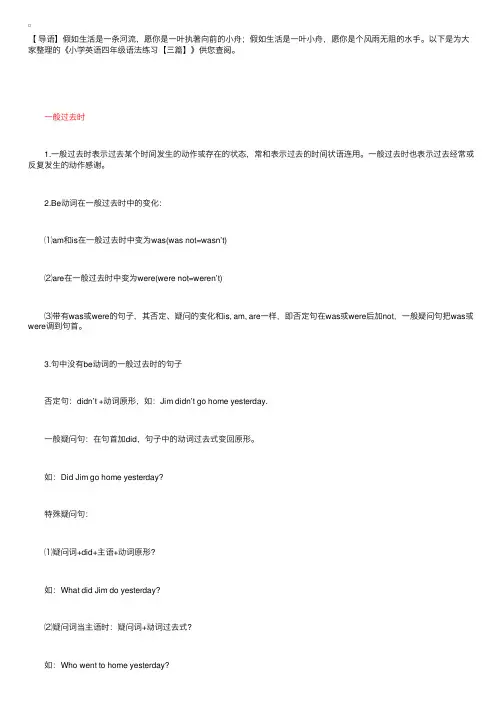
【导语】假如⽣活是⼀条河流,愿你是⼀叶执著向前的⼩⾈;假如⽣活是⼀叶⼩⾈,愿你是个风⾬⽆阻的⽔⼿。
以下是为⼤家整理的《⼩学英语四年级语法练习【三篇】》供您查阅。
⼀般过去时 1.⼀般过去时表⽰过去某个时间发⽣的动作或存在的状态,常和表⽰过去的时间状语连⽤。
⼀般过去时也表⽰过去经常或反复发⽣的动作感谢。
2.Be动词在⼀般过去时中的变化: ⑴am和is在⼀般过去时中变为was(was not=wasn’t) ⑵are在⼀般过去时中变为were(were not=weren’t) ⑶带有was或were的句⼦,其否定、疑问的变化和is, am, are⼀样,即否定句在was或were后加not,⼀般疑问句把was或were调到句⾸。
3.句中没有be动词的⼀般过去时的句⼦ 否定句:didn’t +动词原形,如:Jim didn’t go home yesterday. ⼀般疑问句:在句⾸加did,句⼦中的动词过去式变回原形。
如:Did Jim go home yesterday? 特殊疑问句: ⑴疑问词+did+主语+动词原形? 如:What did Jim do yesterday? ⑵疑问词当主语时:疑问词+动词过去式? 如:Who went to home yesterday? ⼀般现在时 其动词形式是:动词原形(只有第三⼈称单数作主语时除外,要加-s)其疑问句和否定句需要⽤助动词do或does 1) 肯定句⽤⾏为动词原形表⽰ They get up very early every morning. 他们每天早晨起来很早。
I visit my grandparents four times a month. 我⼀个⽉去看望祖⽗母四次。
2) 否定句⽤don’t + 动词原形来表⽰ We do not go shopping on Sundays. 我们周⽇不去购物。
I don’t think you like this colour. 我想你不喜欢这个颜⾊。
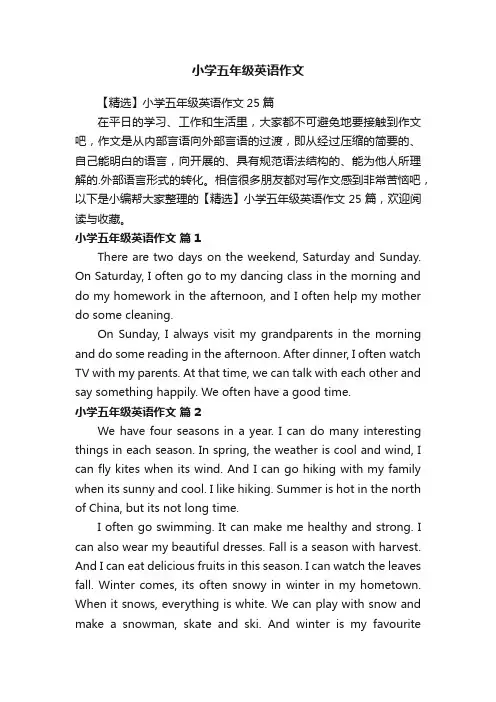
小学五年级英语作文【精选】小学五年级英语作文25篇在平日的学习、工作和生活里,大家都不可避免地要接触到作文吧,作文是从内部言语向外部言语的过渡,即从经过压缩的简要的、自己能明白的语言,向开展的、具有规范语法结构的、能为他人所理解的.外部语言形式的转化。
相信很多朋友都对写作文感到非常苦恼吧,以下是小编帮大家整理的【精选】小学五年级英语作文25篇,欢迎阅读与收藏。
小学五年级英语作文篇1There are two days on the weekend, Saturday and Sunday. On Saturday, I often go to my dancing class in the morning and do my homework in the afternoon, and I often help my mother do some cleaning.On Sunday, I always visit my grandparents in the morning and do some reading in the afternoon. After dinner, I often watch TV with my parents. At that time, we can talk with each other and say something happily. We often have a good time.小学五年级英语作文篇2We have four seasons in a year. I can do many interesting things in each season. In spring, the weather is cool and wind, I can fly kites when its wind. And I can go hiking with my family when its sunny and cool. I like hiking. Summer is hot in the north of China, but its not long time.I often go swimming. It can make me healthy and strong. I can also wear my beautiful dresses. Fall is a season with harvest. And I can eat delicious fruits in this season. I can watch the leaves fall. Winter comes, its often snowy in winter in my hometown. When it snows, everything is white. We can play with snow and make a snowman, skate and ski. And winter is my favouriteseason, because of the Spring Festival. I love seasons. I love the nature.小学五年级英语作文篇3Who is your favorite people? My favorite people is my mother. She is beautiful. She is 38 years old. She is tall and thin. She has big eyes and long hair.She likes cooking. She cooks good meals for us every day. And she always does all the housework. She looks after my father and me. I love my mother very much.小学五年级英语作文篇4My English teacher has a big house.It has a living room, a big dining room, two bedrooms, a study, two bathrooms and a big kitchen.In the living room, there is a big picture, four brown sofas, white fans and blue walls. The TV set is big. There is a big Chinese knot on the wall. There are lanterns below the lights. I like them.This is my English teacher’s house.我的英语老师有一所大房子。
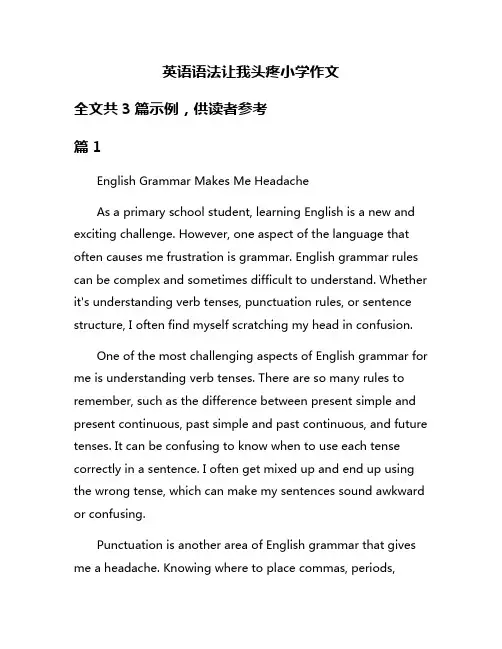
英语语法让我头疼小学作文全文共3篇示例,供读者参考篇1English Grammar Makes Me HeadacheAs a primary school student, learning English is a new and exciting challenge. However, one aspect of the language that often causes me frustration is grammar. English grammar rules can be complex and sometimes difficult to understand. Whether it's understanding verb tenses, punctuation rules, or sentence structure, I often find myself scratching my head in confusion.One of the most challenging aspects of English grammar for me is understanding verb tenses. There are so many rules to remember, such as the difference between present simple and present continuous, past simple and past continuous, and future tenses. It can be confusing to know when to use each tense correctly in a sentence. I often get mixed up and end up using the wrong tense, which can make my sentences sound awkward or confusing.Punctuation is another area of English grammar that gives me a headache. Knowing where to place commas, periods,question marks, and exclamation points in a sentence can be tricky. Sometimes I forget to use punctuation altogether, making my writing hard to read and understand. Other times, I overuse punctuation, which can make my writing seem choppy or disjointed. Finding the right balance of punctuation is something I still struggle with.Sentence structure is yet another aspect of English grammar that confuses me. Knowing how to structure a sentence correctly with subjects, verbs, and objects can be challenging. Sometimes I end up with run-on sentences that are too long and confusing. Other times, my sentences are too short and lack detail. Finding the right balance of sentence structure is something I am still working on improving.Despite the challenges of learning English grammar, I know that practice makes perfect. By studying grammar rules, practicing writing sentences, and asking for help when I need it, I can improve my understanding of English grammar. I know that with time and effort, I will become more confident in my grammar skills and be able to express myself more clearly and effectively in English.In conclusion, English grammar may give me a headache at times, but I am determined to conquer it. With perseverance andpractice, I know that I can overcome the challenges of learning English grammar and become a more proficient English speaker and writer.篇2English Grammar Gives Me a HeadacheEnglish grammar is a subject that many students find challenging. The rules and exceptions can be overwhelming, leading to confusion and frustration. As a primary school student, I often struggle with the intricacies of English grammar, and it can feel like a never-ending battle to grasp all the rules and apply them correctly.One of the most daunting aspects of English grammar is the sheer number of rules that need to be memorized. From subject-verb agreement to tenses and sentence structure, there are countless rules that govern how we use the English language. Trying to remember all of these rules can be overwhelming, especially for young students who are still developing their language skills.Another challenge of English grammar is the exceptions to the rules. Just when you think you have a rule figured out, you come across an exception that throws everything off. Theseexceptions can be tricky to navigate, and they can make it difficult to apply the rules consistently. For students like me who prefer clear, straightforward guidelines, the exceptions can be a major source of frustration.In addition to the rules and exceptions, English grammar also requires a good understanding of vocabulary and syntax. Knowing which words to use and where to place them in a sentence is essential for conveying meaning effectively. This can be especially challenging for students who are still building their vocabulary and struggling to express themselves in English.Despite the difficulties that come with learning English grammar, I know that it is an essential skill that I need to master. Clear communication is crucial in both academic and professional settings, and having a strong grasp of grammar can help me express my thoughts and ideas effectively. So, even though English grammar may give me a headache at times, I am determined to keep learning and improving my skills.In conclusion, English grammar is a challenging subject that can be overwhelming for students, especially at the primary school level. The rules, exceptions, vocabulary, and syntax all require careful attention and practice to master. Despite thechallenges, I am committed to developing my English grammar skills so that I can communicate effectively in the future.篇3English grammar makes my head ache. As a primary school student, I have always struggled with the rules and structures of the English language. From the differences between "there", "their" and "they're" to the various tenses and verb forms, I find myself constantly getting confused and frustrated.One of the most challenging aspects of English grammar for me is the use of articles. Knowing when to use "a", "an" or "the" seems like such a simple task, but I often find myself making mistakes. I have a hard time remembering all the rules and exceptions that come with articles, and it can be really frustrating when I get them wrong.Another aspect of English grammar that gives me trouble is verb conjugation. With so many irregular verbs and exceptions to the rules, it can be difficult to remember how to conjugate each verb correctly. I often mix up the past tense, present tense and future tense forms of verbs, which can lead to confusing sentences and misunderstandings.Punctuation is another area where I struggle. Knowing when to use a comma, semicolon, or dash can be confusing, and I often find myself overusing or underusing punctuation marks. It can be hard to remember all the rules and guidelines for proper punctuation, and this can lead to me making mistakes in my writing.Despite all these challenges, I know that improving my understanding of English grammar is important. By studying hard, practicing regularly, and seeking help from teachers and tutors, I hope to become more confident and proficient in using correct grammar. I know that with time and effort, I can overcome my struggles and master the rules of English grammar.。
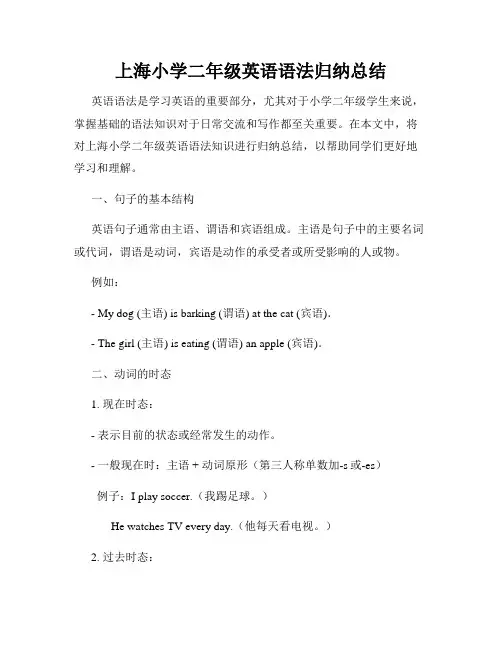
上海小学二年级英语语法归纳总结英语语法是学习英语的重要部分,尤其对于小学二年级学生来说,掌握基础的语法知识对于日常交流和写作都至关重要。
在本文中,将对上海小学二年级英语语法知识进行归纳总结,以帮助同学们更好地学习和理解。
一、句子的基本结构英语句子通常由主语、谓语和宾语组成。
主语是句子中的主要名词或代词,谓语是动词,宾语是动作的承受者或所受影响的人或物。
例如:- My dog (主语) is barking (谓语) at the cat (宾语).- The girl (主语) is eating (谓语) an apple (宾语).二、动词的时态1. 现在时态:- 表示目前的状态或经常发生的动作。
- 一般现在时:主语 + 动词原形(第三人称单数加-s或-es)例子:I play soccer.(我踢足球。
)He watches TV every day.(他每天看电视。
)2. 过去时态:- 表示过去发生的动作或状态。
- 一般过去时:主语 + 动词过去式例子:I played soccer yesterday.(我昨天踢足球了。
)She watched a movie last night.(她昨晚看了一部电影。
)3. 将来时态:- 表示将来要发生的动作或情况。
- 一般将来时:主语 + will + 动词原形例子:I will go to the park tomorrow.(我明天要去公园。
)They will have a party next week.(他们下周要开派对。
)三、名词名词是指人、物、地点或概念。
在句子中一般作为主语、宾语或补语。
1. 可数名词:- 单数形式:一个 + 名词单数形式- 复数形式:两个(几个)+ 名词复数形式例子:There is a cat.(这里有一只猫。
)There are two cats.(这里有两只猫。
)2. 不可数名词:- 通常表示无法具体计数的名词。
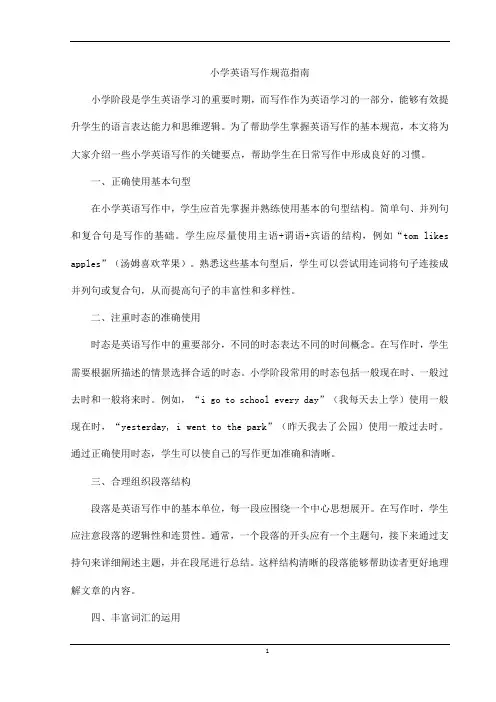
小学英语写作规范指南小学阶段是学生英语学习的重要时期,而写作作为英语学习的一部分,能够有效提升学生的语言表达能力和思维逻辑。
为了帮助学生掌握英语写作的基本规范,本文将为大家介绍一些小学英语写作的关键要点,帮助学生在日常写作中形成良好的习惯。
一、正确使用基本句型在小学英语写作中,学生应首先掌握并熟练使用基本的句型结构。
简单句、并列句和复合句是写作的基础。
学生应尽量使用主语+谓语+宾语的结构,例如“tom likes apples”(汤姆喜欢苹果)。
熟悉这些基本句型后,学生可以尝试用连词将句子连接成并列句或复合句,从而提高句子的丰富性和多样性。
二、注重时态的准确使用时态是英语写作中的重要部分,不同的时态表达不同的时间概念。
在写作时,学生需要根据所描述的情景选择合适的时态。
小学阶段常用的时态包括一般现在时、一般过去时和一般将来时。
例如,“i go to school every day”(我每天去上学)使用一般现在时,“yesterday, i went to the park”(昨天我去了公园)使用一般过去时。
通过正确使用时态,学生可以使自己的写作更加准确和清晰。
三、合理组织段落结构段落是英语写作中的基本单位,每一段应围绕一个中心思想展开。
在写作时,学生应注意段落的逻辑性和连贯性。
通常,一个段落的开头应有一个主题句,接下来通过支持句来详细阐述主题,并在段尾进行总结。
这样结构清晰的段落能够帮助读者更好地理解文章的内容。
四、丰富词汇的运用丰富的词汇是提高英语写作水平的关键。
学生应尽量避免重复使用相同的词汇,可以通过学习同义词来增加写作的多样性。
例如,可以用“happy”代替“glad”,用“big”代替“large”。
此外,学生还应注意不同词汇的适用场景和语境,以确保词汇使用的准确性。
五、正确使用标点符号标点符号在英语写作中起到至关重要的作用,能够帮助分隔句子,使文章结构更加清晰。
在小学英语写作中,常用的标点符号包括句号(.)、逗号(,)、问号(?)和感叹号(!)。
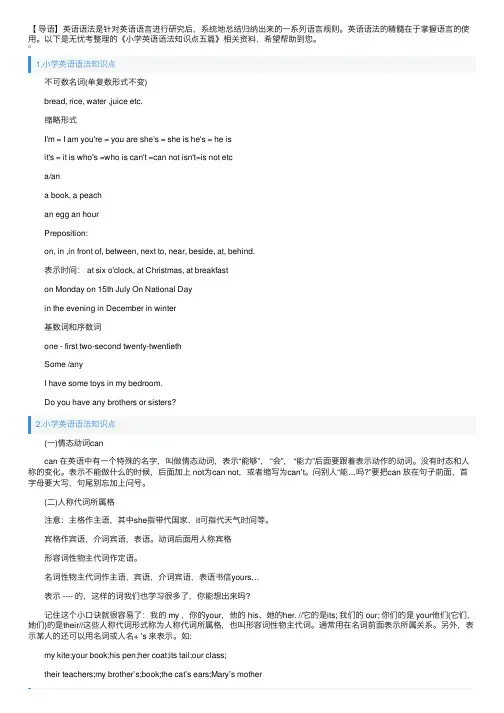
【导语】英语语法是针对英语语⾔进⾏研究后,系统地总结归纳出来的⼀系列语⾔规则。
英语语法的精髓在于掌握语⾔的使⽤。
以下是⽆忧考整理的《⼩学英语语法知识点五篇》相关资料,希望帮助到您。
1.⼩学英语语法知识点 不可数名词(单复数形式不变) bread, rice, water ,juice etc. 缩略形式 I'm = I am you're = you are she's = she is he's = he is it's = it is who's =who is can't =can not isn't=is not etc a/an a book, a peach an egg an hour Preposition: on, in ,in front of, between, next to, near, beside, at, behind. 表⽰时间: at six o'clock, at Christmas, at breakfast on Monday on 15th July On National Day in the evening in December in winter 基数词和序数词 one - first two-second twenty-twentieth Some /any I have some toys in my bedroom. Do you have any brothers or sisters?2.⼩学英语语法知识点 (⼀)情态动词can can 在英语中有⼀个特殊的名字,叫做情态动词,表⽰“能够”, “会”, “能⼒”后⾯要跟着表⽰动作的动词。
没有时态和⼈称的变化。
表⽰不能做什么的时候,后⾯加上 not为can not,或者缩写为can’t。
问别⼈“能…吗?”要把can 放在句⼦前⾯,⾸字母要⼤写,句尾别忘加上问号。
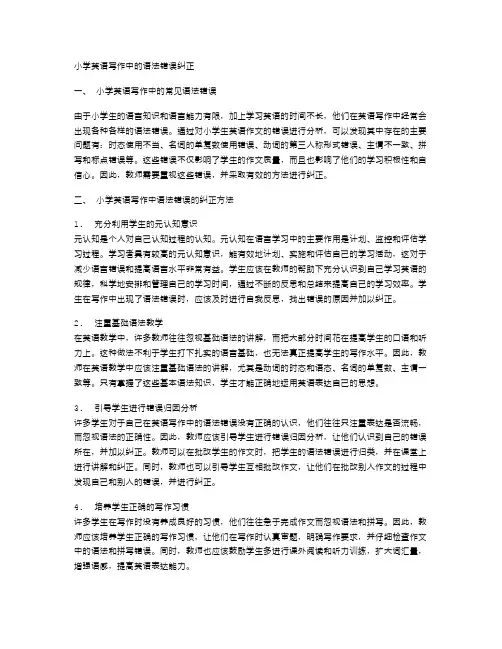
小学英语写作中的语法错误纠正一、小学英语写作中的常见语法错误由于小学生的语言知识和语言能力有限,加上学习英语的时间不长,他们在英语写作中经常会出现各种各样的语法错误。
通过对小学生英语作文的错误进行分析,可以发现其中存在的主要问题有:时态使用不当、名词的单复数使用错误、动词的第三人称形式错误、主谓不一致、拼写和标点错误等。
这些错误不仅影响了学生的作文质量,而且也影响了他们的学习积极性和自信心。
因此,教师需要重视这些错误,并采取有效的方法进行纠正。
二、小学英语写作中语法错误的纠正方法1.充分利用学生的元认知意识元认知是个人对自己认知过程的认知。
元认知在语言学习中的主要作用是计划、监控和评估学习过程。
学习者具有较高的元认知意识,能有效地计划、实施和评估自己的学习活动,这对于减少语言错误和提高语言水平非常有益。
学生应该在教师的帮助下充分认识到自己学习英语的规律,科学地安排和管理自己的学习时间,通过不断的反思和总结来提高自己的学习效率。
学生在写作中出现了语法错误时,应该及时进行自我反思,找出错误的原因并加以纠正。
2.注重基础语法教学在英语教学中,许多教师往往忽视基础语法的讲解,而把大部分时间花在提高学生的口语和听力上。
这种做法不利于学生打下扎实的语言基础,也无法真正提高学生的写作水平。
因此,教师在英语教学中应该注重基础语法的讲解,尤其是动词的时态和语态、名词的单复数、主谓一致等。
只有掌握了这些基本语法知识,学生才能正确地运用英语表达自己的思想。
3.引导学生进行错误归因分析许多学生对于自己在英语写作中的语法错误没有正确的认识,他们往往只注重表达是否流畅,而忽视语法的正确性。
因此,教师应该引导学生进行错误归因分析,让他们认识到自己的错误所在,并加以纠正。
教师可以在批改学生的作文时,把学生的语法错误进行归类,并在课堂上进行讲解和纠正。
同时,教师也可以引导学生互相批改作文,让他们在批改别人作文的过程中发现自己和别人的错误,并进行纠正。
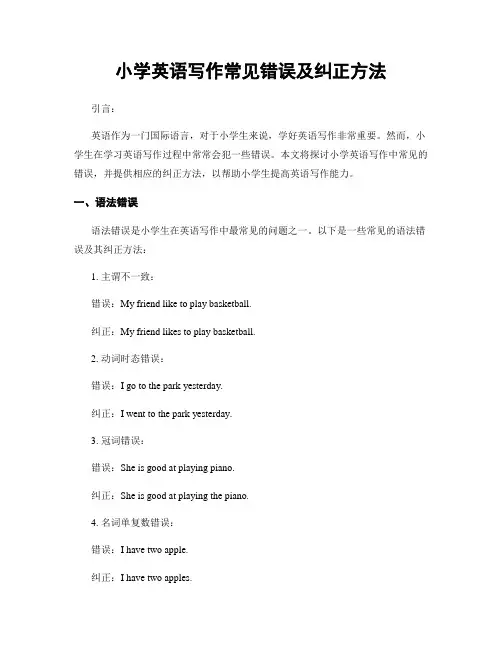
小学英语写作常见错误及纠正方法引言:英语作为一门国际语言,对于小学生来说,学好英语写作非常重要。
然而,小学生在学习英语写作过程中常常会犯一些错误。
本文将探讨小学英语写作中常见的错误,并提供相应的纠正方法,以帮助小学生提高英语写作能力。
一、语法错误语法错误是小学生在英语写作中最常见的问题之一。
以下是一些常见的语法错误及其纠正方法:1. 主谓不一致:错误:My friend like to play basketball.纠正:My friend likes to play basketball.2. 动词时态错误:错误:I go to the park yesterday.纠正:I went to the park yesterday.3. 冠词错误:错误:She is good at playing piano.纠正:She is good at playing the piano.4. 名词单复数错误:错误:I have two apple.纠正:I have two apples.二、拼写错误拼写错误是小学生英语写作中另一个常见的问题。
以下是一些常见的拼写错误及其纠正方法:1. 单词拼写错误:错误:I have a frend.纠正:I have a friend.2. 句子中的拼写错误:错误:I like to reed books.纠正:I like to read books.3. 同音异义词拼写错误:错误:I see a pear in the tree.纠正:I see a pair in the tree.三、词汇错误词汇错误也是小学生英语写作中常见的问题。
以下是一些常见的词汇错误及其纠正方法:1. 词性错误:错误:I am very exciting to go to the zoo.纠正:I am very excited to go to the zoo.2. 用词不准确:错误:I am very hungry. I want to eat a big elephant.纠正:I am very hungry. I want to eat a big hamburger.3. 重复使用相同的词:错误:I like to play play soccer.纠正:I like to play soccer.四、句子结构错误句子结构错误也是小学生英语写作中常见的问题。
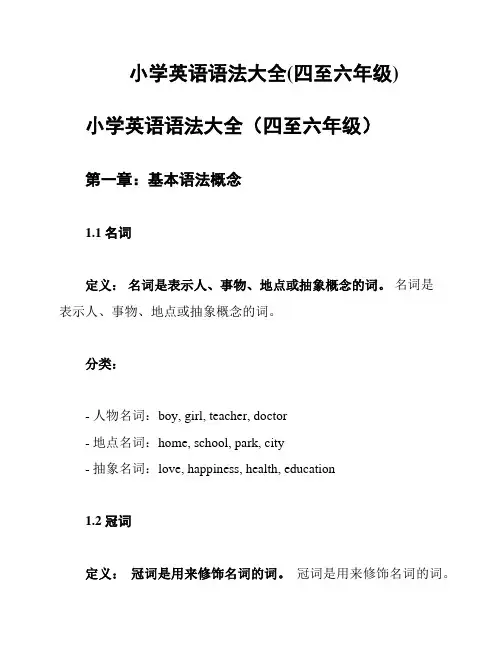
小学英语语法大全(四至六年级)小学英语语法大全(四至六年级)第一章:基本语法概念1.1 名词定义:名词是表示人、事物、地点或抽象概念的词。
名词是表示人、事物、地点或抽象概念的词。
分类:- 人物名词:boy, girl, teacher, doctor- 地点名词:home, school, park, city- 抽象名词:love, happiness, health, education1.2 冠词定义:冠词是用来修饰名词的词。
冠词是用来修饰名词的词。
分类:- 不定冠词:a, an- 定冠词:the1.3 代词定义:代词是用来代替名词的词。
代词是用来代替名词的词。
分类:- 人称代词:I, you, he, she, it, we, they- 物主代词:my, your, his, her, its, our, their- 反身代词:myself, yourself, himself等1.4 形容词和副词定义:- 形容词:用来修饰名词的词。
- 副词:用来修饰动词、形容词或其他副词的词。
比较级和最高级:- 比较级:表示两个事物之间的比较。
如:bigger, smaller- 最高级:表示多个事物中的最高或最低。
如:biggest, smallest 第二章:动词2.1 动词的分类- 行为动词:run, jump, read, write- 状态动词:be, have, exist- 助动词:do, does, did, can, may, shall, will2.2 动词的时态- 现在时:表示现在或经常发生的事。
如:I read a book.- 过去时:表示过去发生的事。
如:I read a book yesterday.- 将来时:表示将来会发生的的事。
如:I will read a book tomorrow.第三章:句子结构3.1 简单句简单句是由一个主语和一个谓语构成的句子。
如:The cat sleeps.3.2 复合句复合句是由两个或两个以上的简单句合并而成的句子。
小学五年级英语作文复习要点1. 语法- 五年级英语作文要求掌握基本的语法知识,包括动词的时态、名词的单复数和代词的使用等。
- 时态:现在时、过去时和将来时。
- 名词的单复数:可数名词和不可数名词的区分,以及名词的复数形式。
- 代词的使用:主格、宾格和所有格的区别。
2. 句型结构- 五年级英语作文中要求运用简单的句型结构,如主谓结构、主谓宾结构、There be 句型等。
- 主谓结构:主语和谓语构成简单的句子,如 "I like apples."。
- 主谓宾结构:主语、谓语和宾语构成简单的句子,如 "She eats ice cream."。
- There be 句型:表示存在或出现的句型,如 "There is a cat in the garden."。
3. 词汇- 五年级英语作文要求积累一定的词汇量,包括常见的名词、动词、形容词和副词等。
- 名词:天气、动物、食物、人物等。
- 动词:吃、喝、玩、读等。
- 形容词:大、小、快、慢等。
- 副词:很、非常、有时候等。
4. 内容表达- 五年级英语作文内容要求简单而生动,表达自己的思想和观点。
- 可以以日常生活为主题,描述自己的一天、一次旅行、一次活动等。
- 注意使用简单的词汇和句子结构,避免复杂的表达和长句子。
5. 语言准确性- 五年级英语作文要求注意语言的准确性和流利性。
- 注意动词的时态一致,名词和代词的单复数一致,形容词和副词的用法准确。
- 可以通过多读多写来提高语言的准确性和流利性。
以上是小学五年级英语作文复习的要点,请同学们按照这些要求进行复习和练习,提高英语写作能力。
加油!。
(完整版)小学英语语法总结全集小学英语语法总结全集小学英语语法汇总(一)可数名词与别可数名词“分家”一、可数名词与别可数名词的区不一般名词所表示的人或事物是能够按个数计算的,这类名词叫可数名词。
可数名词分为个体名词(表示某类人或事物中的个体,如worker, farmer, desk, fact ory等)和集体名词(表示作为一具整体来看的一群人或一些事物,如people,fa mily 等)。
假如一般名词所表示的事物是别能按个数来计算的,这类名词就叫别可数名词。
别可数名词分为物质名词(表示无法分为个体的物质,如meat, rice, water, milk, orange 等)和抽象名词(表示动作、状态、事情、品质等抽象概念,如work, homework, time, health, friendship等)。
二、可数名词的家务事可数名词有单数和复数两种形式。
指一具人或一件事物时,用单数形式;指两个或多个人或事物时用复数形式。
名词由单数形式变成复数形式的规则如下: 1. 普通的名词词尾直截了当加-s 。
如:book → books room → roomshouse → houses day → days2. 以s,ss, ch,sh, x 结尾的名词,在词尾加-es 。
如:bus → buses glass → glasseswatch → watchesdish → dishes box → boxes3. 以"辅音字母+y"结尾的名词,要先将y改为i再加-es。
如:city → cities body → bodiesfactory → factories等等。
4. 以f 或fe 结尾的名词,要将f或fe改为v再加-es。
如:half → halves leaf → leavesknife → knives wife → wives5. 特例[悄悄话:特例常常考,要记住。
小学一年级学英语语法小学一年级是学习英语的开始阶段,那么你知道小学一年级的英语语法有哪些吗?下面是店铺为你整理的小学一年级英语语法,希望大家喜欢!小学一年级英语语法1.现在进行时表示正在发生的事情或进行的动作,常与now,listen,look等词连用,结构是主语+be动词(am, is, are)+动词ing.如:It is raining now.外面正在下雨It is six o’clock now.现在6点了My parents are reading newspapers in the sitting room.我父母正在客厅看报纸Look! The children are having a running race now.看!孩子们正在赛跑问句将be动词移前,否定句在be动词后+not.2.一般现在时表示经常反复发生的事情或动作,常与often, usually, sometimes, always, every day(week year…) on Sundays等词连用。
结构是主语+动词原形;当主语为第三人称单数即he,she, it, Tom, my mother, the boy等词时,动词后加s或es.如:We have an English lesson every day.我们每天都要上英语课Do the boys run faster than the girls? Yes, they do.男孩比女孩跑的快吗?是的问句借助于do, does否定句借助于don’t, doesn’t,后面动词一定要还原。
3.一般过去时表示发生在过去的事情或存在的状态,常与just now; a moment ago; … ago; yesterday; last ( week; month; year; Monday; weekend); this morning等词连用。
结构是主语+be动词的过去式(was; were)或主语+动词的过去式。
小学六年级英语写作常见错误分析在小学六年级阶段,学生在英语写作中常犯一些错误,这些错误不仅影响了语言表达的准确性,也影响了整体的写作质量。
以下从教育角度,以拟人立场分析这些常见错误,并提出改进建议。
首先,常见的错误之一是语法错误。
语法就像一座坚固的桥梁,连接着句子和段落。
然而,有时学生在使用动词时可能出现时态错误,比如混淆过去时和现在时。
这就好像在修建桥梁时,把石头和沙子放错了位置,桥梁就不能稳固地支撑起来。
为了改进这一点,学生可以多加练习,特别是通过阅读和模仿优秀的句子结构来提升自己的语法意识。
其次,常见的错误是拼写和标点符号的错误。
这就像在写字的时候,笔划不够清晰,或者忘记了在句子的结尾打上逗号或句号一样。
拼写错误会让读者难以理解作者的意图,标点符号的错误则会影响句子的流畅性和表达的准确性。
要改进这一点,学生可以通过多次校对和使用拼写检查工具来提高自己的拼写和标点符号的准确性。
第三个常见的错误是句子结构的混乱。
有时候,学生会在一句话中使用过多的连接词或者重复使用相同的句型,导致句子结构杂乱无章,读起来让人感到困惑。
这就好比在建造房子时,墙体的结构不规则,房子就会显得不稳固。
为了改进这一点,学生可以学习多样化的句子结构,避免过多的复杂连接词,并在写作过程中保持逻辑清晰、结构合理。
最后,还有一个常见的错误是词汇选择不当。
有时学生会在写作中使用一些不恰当或者难以理解的词汇,这会影响读者对文章内容的理解和感受。
这就像在画画时选择了不合适的颜色一样,使得整幅画面显得单调乏味。
为了改进这一点,学生可以通过扩展自己的词汇量,多阅读和积累优秀的表达方式,从而提升自己的词汇选择水平。
总而言之,小学六年级的英语写作中常见的错误包括语法错误、拼写和标点符号的错误、句子结构混乱以及词汇选择不当。
通过针对性的练习和持续的学习,学生可以逐步改进这些问题,提升自己的写作能力和表达准确性,使自己的作品更加流畅、清晰和有吸引力。
1:“first”是序数词,与“the”相连,解释为第一。
2:像“first,term,world”作为词组出现时前面要加“the”。
3:“all”所有;后面的可数名词用复数形式,be动词用“are”。
4:“any”一些;用在否定句和一般疑问句中,与“some”同义。
“some”用在肯定句中。
5:there be+数词,采用“就近原则”。
6:a map of China 与 a map of the world 要牢记。
7:要用“on the wall”,不能用“in the wall”。
门、窗在墙上才能用“in the wall”。
8:can 后+动词原形。
9:play+the+乐器; play+球类;10:like的用法11:动词变动名词形式方法:A--直接在动词后面+ing形式(大多数)。
B--以不发音的“e”结尾的,要去掉e后再+ing,比如:dancing,making,riding。
C--重读be音节,末尾只有一个辅音,须双写末尾的字母后再+ing,如:running,swimmi ng,sitting,putting。
12:现在进行时的构成:be动词+动词ing形式。
标志:now、look、listen、its time to。
13:现在进行时的一般疑问句 /问--be动词+人称+时态(动词ing)答--Yes,he/She/it is/am/are. No,he/She/it isnt/arent/am not.14:用Are you...? Yes,I am/ we are. No,Im not/We arent.15: 动词后+人称宾格形式.16:一般现在时的构成:第三人称单数(三单)。
要注意:后面的动词+s或es。
特例:have→has do→dose go→goes; 标志:often,usually。
17:有些名词变动词时要变形式,例如:teacher→teach;driver→drive.1.一般现在时一般现在时态中,动词一般用原形。
小学英语语法大全(完整版)小学英语语法大全第一章:名词一、定义名词是用来表示人或事物名称的词语。
它可以表示具体的事物,也可以表示抽象的概念。
二、分类1.名词可以根据意义分为普通名词和专有名词。
例如,john是一个学生,其中student是普通名词,而john是专有名词。
普通名词前可以用不定冠词a/an,定冠词the或不加冠词,而专有名词前一般不加冠词。
另外,专有名词的首字母要大写。
2.普通名词又可以分为个体名词、集体名词、物质名词和抽象名词。
其中,个体名词和集体名词是可数名词,而物质名词和抽象名词是不可数名词。
3.专有名词专有名词是用来表示人名、地名、团体、机构、组织等的专有名词,多数情况下是独一无二的。
三、名词的数1、名词可以分为可数名词和不可数名词。
可数名词——可以数的名词不可数名词——数不清(没有复数形式)例如:drink(饮料)、milk(牛奶)、tea(茶)、water (水)、orange juice(橙汁)、coke(可乐)、coffee(咖啡)、porridge(粥)、food(食物)、rice(米饭)、bread(面包)、meat(肉类)、fish(鱼)、fruit(水果)、cake (蛋糕)、dumplings(饺子)2、可数名词可以与不定冠词a/an连用,有复数形式。
而不可数名词不能与不定冠词连用,也没有复数形式。
在修饰可数名词时,可以直接使用数词。
而在修饰不可数名词时,需要使用量词。
例如:many+可数名词复数;不可数名词用much/alittle+some/any/a lot of3、不可数名词的数量可以用以下两种方式表示:第一种方式是使用等量词,例如:some、much、a little、a lot of、a bit of、plenty of等。
注意,有些词既可以与可数名词复数连用,也可以与不可数名词连用,例如:plenty of、some、a lot of、lots of、等等。